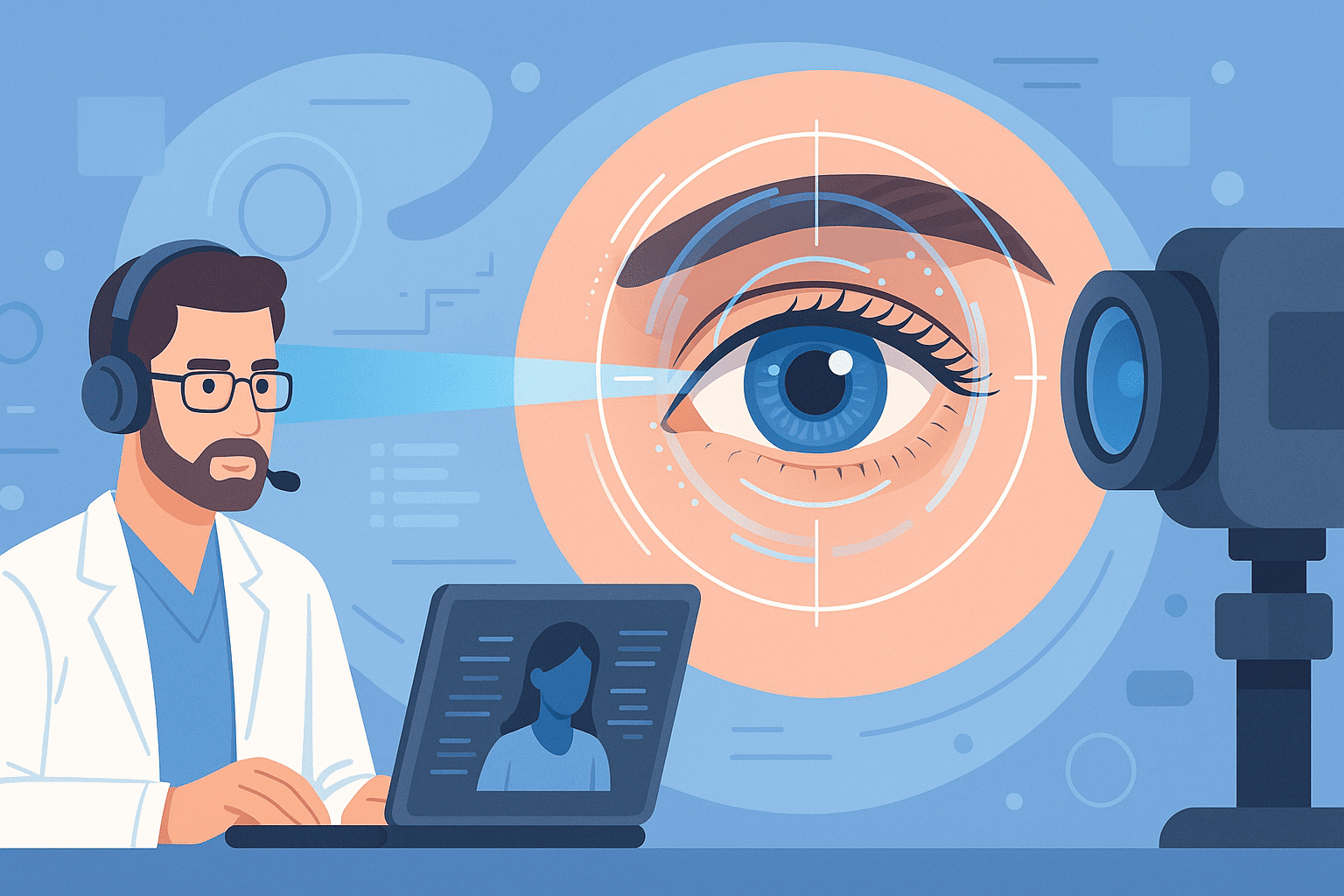Updated on: July 15, 2025
Whether it’s a routine vision check or complex retinal surgery, ophthalmologists rely on rapid, accurate assessments backed by high-resolution diagnostics. But capturing those insights in clear, compliant notes? That’s where the challenge begins.
You’re documenting:
-
Visual acuity
-
Refractions and intraocular pressures
-
OCT, fluorescein angiography, or visual field tests
-
Surgical planning and post-op outcomes
-
Diagnoses across cataracts, glaucoma, diabetic retinopathy, and more
It’s fast-paced, multi-modal, and manually exhausting. That’s why leading eye care professionals now rely on DocScrib, the AI medical scribe built for ophthalmology.
Why Ophthalmology Documentation Is Complex
A single ophthalmology visit might involve:
-
Chief complaint & history (e.g., blurred vision, floaters, pain, photophobia)
-
Refraction and visual acuity testing
-
Slit-lamp, fundus, and intraocular pressure exams
-
Specialty testing (OCT, FAF, visual field, ERG)
-
Diagnosis documentation (glaucoma, AMD, DR, cataracts, uveitis)
-
Surgical planning or post-op status
-
Interdisciplinary referrals (e.g., endocrinology, neurology)
Each data point is critical—and missed or delayed documentation can impact care quality or compliance.
What Is an AI Medical Scribe for Ophthalmology?
DocScrib’s AI ophthalmology scribe listens securely during your patient encounters and generates a complete, structured note—covering everything from exam findings to procedure plans.
Unlike basic dictation tools, DocScrib is trained to understand ophthalmic terminology, test results, and anatomical references—turning your clinical talk into EMR-ready documentation.
How DocScrib Works in Ophthalmology Clinics
-
Begin the encounter
The AI listens securely in the background during your consultation. -
Real-time comprehension
It understands VA scores, slit lamp findings, test results, and assessments. -
Note generation
Generates full SOAP, follow-up, or surgical notes tailored to ophthalmology. -
Review + sync
You approve the draft and sync it directly to your EMR.
Why Ophthalmologists Trust DocScrib
👁️ Captures Eye-Specific Symptoms Clearly
Auto-documents vision loss, halos, floaters, pain, flashes, diplopia, and photophobia.
🔍 Logs Visual Acuity & IOP Accurately
Near/far vision, pinhole testing, and intraocular pressure readings included instantly.
🧪 Inserts Diagnostic Imaging & Test Results
OCT, fundus photos, FA/ICG, and visual field interpretations documented correctly.
🛠️ Supports Pre- and Post-Op Surgical Notes
For cataracts, LASIK, vitrectomy, trabeculectomy, intravitreal injections, and more.
🧠 Summarizes Findings Across Systems
From anterior segment to retina and optic nerve—notes are well-organized and complete.
DocScrib Features Designed for Ophthalmology
-
Comprehensive Ophthalmology SOAP Templates
Cataract, glaucoma, AMD, diabetic eye disease, uveitis, dry eye, and more. -
Diagnostic Test Parser
Automatically integrates OCT, VF, IOL measurements, corneal topography, and imaging results. -
Surgical Note Templates
Includes pre-op consent, intra-op notes, and post-op follow-ups. -
Medication & Drops Tracker
Logs eye drops, systemic meds, antibiotic prophylaxis, and steroids. -
Chronic Disease Monitoring
Tracks AMD progression, IOP trends, and diabetic retinopathy changes over time.
Top Use Cases for AI Scribes in Ophthalmology
-
Cataract Evaluations: BCVA, lens opacity grading, IOL measurements
-
Glaucoma Follow-Ups: IOP logs, OCT RNFL/optic nerve, VF test tracking
-
Diabetic Eye Exams: Fundus imaging, retinal hemorrhage documentation, macular edema
-
Emergency Visits: Eye pain, corneal abrasions, retinal detachments, foreign bodies
-
Post-Surgical Checkups: Wound healing, pressure checks, visual outcome updates
-
Pediatric Eye Exams: Strabismus, amblyopia management, visual acuity logs
-
LASIK and Refractive Surgery: Topography results, flap evaluations, visual outcomes
Case Study: Retina Center in Texas
📍 4 retina specialists + 3 general ophthalmologists
In Just 30 Days:
-
Cut documentation time by 75%
-
Improved consistency in OCT/FA documentation
-
Enabled real-time note generation during procedures
-
Reduced staff burnout and increased patient throughput by 10%
💬 “With DocScrib, our intravitreal injection notes are ready before the patient walks out. It’s like having a live transcriptionist who speaks ophthalmology.”
DocScrib vs. Manual Eye Care Documentation
| Feature | Manual Notes | DocScrib AI Scribe |
|---|---|---|
| Visual Acuity/IOP Logging | Typed manually | ✅ Auto-inserted |
| Imaging Summary | Requires copy/paste | ✅ Structured from source |
| Procedure Documentation | Manually templated | ✅ Built-in, editable |
| Medication Instructions | May be inconsistent | ✅ Tracked and organized |
| Chronic Disease Monitoring | Requires chart review | ✅ Trend summaries included |
| Time Per Note | 10–15 min | ✅ Under 2 minutes |
FAQs: AI Scribes for Ophthalmology
Q1. Can DocScrib log visual acuity and IOP?
Yes—DocScrib captures near and distance VA (OD/OS) along with accurate IOP recordings.
Q2. Does it support diagnostic imaging integration?
Absolutely. OCT, visual fields, fundus photos, and other test summaries are parsed and inserted automatically.
Q3. Can I use it during procedures?
Yes—DocScrib supports intra-op and post-op documentation for common office and OR procedures.
Q4. Is it compliant with HIPAA and ophthalmology-specific EMRs?
Yes—DocScrib is HIPAA-compliant and integrates with leading ophthalmology EMRs like NextGen, Compulink, and more.
Get Started with DocScrib for Ophthalmology
-
Book a free demo
-
Select “Ophthalmology” as your specialty
-
Customize templates for retina, glaucoma, cataract, LASIK, and more
-
Start saving hours on charting—instantly
Conclusion: Let Your Documentation Reflect the Clarity of Your Vision
Your work requires precision, speed, and compassion. Don’t let documentation cloud your care.
With DocScrib’s AI medical scribe for ophthalmology, your notes are sharper, faster, and fully tailored to how you practice—whether you’re treating cataracts, managing glaucoma, or saving vision in diabetic patients.
🩺 Focus on sight—not typing → Try DocScrib for Ophthalmology
